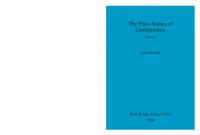Pocket Place Names of Hawai'i 9780824843458
Pukui Mary Kawena : Mary Kawena Pukui was a noted authority on the Hawaiian language. She had a long professional ass
224 20 7MB
English Pages 96 Year 2022
Recommend Papers

- Author / Uploaded
- Mary Kawena Pukui
- Samuel H. Elbert
- Esther T. Mookini
File loading please wait...
Citation preview
Pocket Place Names of Hawaii Mary Kawena Pukui / Samuel H. Elbert / Esther T. Mookini
U N I V E R S I T Y OF HAWAII PRESS HONOLULU
©1966, 1974, 1989 University of Hawaii Press M a n u f a c t u r e d in the United States of America
Library of Congress Cataloging-in-Publication Data P u k u i , Mary Kawena, 1895Pocket place names of H a w a i ' i . Abridged ed. of: Place names of Hawaii. Bibliography: p. 1. Names, Geographical—Hawaii. 2. Hawaii— Gazetteers. 3. Hawaiian language—Etymology—Names— Dictionaries. I. Elbert, Samuel H . , 1907II. Mookini, Esther T. 111. P u k u i , M a r y Kawena, 1895. Place names of Hawaii. IV. Title. DU622.P792 1988 919.69'003'21 88-27747 ISBN 0 - 8 2 4 8 - 1 1 8 7 - 9 (pbk.)
Preface Maps
v ix
Pronunciation of Hawaiian
xv
Pocket Place Names of Hawai'i Hawaiian
Words Used in the
Abbreviations References
77
2
1 Glossary
Preface
Pocket Place Names of Hawai'i is an abridgement of Place Names of Hawaii by Pukui, Elbert, and Mookini, hereafter referred to as PN. It is hoped that this much-shortened version will serve as a useful companion volume to The Pocket Hawaiian Dictionary by the same authors. The following materials from PN are reproduced here, with slight necessary emendation: maps 1 through 6, Hawaiian Words Used in the Glossary, and Abbreviations. The section on pronunciation of Hawaiian is taken from The Pocket Hawaiian Dictionary, and the Preface and Appendix from PN have been condensed and combined for this volume. The References section is for this work only. In selecting entries from PN for inclusion in Pocket Place Names of Hawai'i I chose those places that are prominently displayed on maps of the state of Hawai'i, those featured as visitor destinations, and others that seemed to me to be of particular interest to both visitor and kama'Qina. I concentrated my attention on beaches and beach parks; national, state, and county parks; historic sites; and Wai-klkl and Honolulu street and building names. Where a change in name has occurred, I made the appropriate correction along with informational data (see Neal Blaisdell Center), and other changes have been made to accord with recently acquired information. Population figures for the state, counties, and towns are updated according to the 1980 census, and new place names that I thought were of importance are added (see Onizuka). Places that have been designated as historic sites in recent years are so noted (see Pahu-kini). Clearly, I have been able to give here only a tiny sampling of the vast number of place names in the islands, for the Hawaiv
Preface
vi
ians gave a name to every knoll and grove, each smallest stream and cove, to canoe landings, fishing sites at sea, taro patches, house sites, and even rocky outcrops. Those interested in the subject will find many additional entries in PN, with fuller explanations. The information given for each entry includes, as far as possible, identification of the place; its location (by quadrangle on Hawai'i, Maui, Moloka'i, and O'ahu, by district on Kaua'i, and by section in Honolulu—see maps); and literal meanings of Hawaiian names and origins for non-Hawaiian names. Abbreviated references, enclosed in parentheses, will lead the interested reader to additional information about the name, and occasionally legends or songs associated with it. (See Abbreviations and References.) The spelling of the place names conforms with that used in the Atlas of Hawaii and the reference maps of the individual islands published by the University of Hawaii Press, all of which the reader will find helpful. It was a major endeavor of Mary Kawena Pukui and Samuel H. Elbert to record the pronunciation of Hawaiian place names as spoken by kupuna (elderly Hawaiians) fluent in the language. To help the frustrated newcomer or visitor master the pronunciation of the place names, I have included a page outlining the basic rules (Pronunciation of Hawaiian). I call particular attention to the symbols for two important elements in the spoken language: the glottal stop (reversed apostrophe) and lengthened, stressed vowels (macron). Without these symbols in the written language, pronunciation of a great many Hawaiian words cannot be determined—nor, it follows, can their meanings be accurately deciphered. As was done in PN as a further aid to understanding meanings of the names, the individual words that make up many Hawaiian names are separated by hyphens and spaces (as in Ka-lihi Uka). These hyphens are not pause signals; each entry word is pronounced as a single word. People in Hawai'i take great delight in knowing and retelling stories that gave rise to and the reason for the name of a particular place. Pele, the volcano goddess, is ever present. The most recent lava flow from Kl-lau-ea has destroyed a number of homes at Kala-pana (see Kapa-ahu). Kama-pua'a, the pig demigod, is kept alive with stories of his wild escapades throughout the islands (see Ka-liu-wa'a). Stories connected with the history of Hawai'i
vii
Preface
are perpetuated in place names (see Ke-pani-wai). Geographical features are prominent in the names (see Wai-klkl). The opportunity to gain some understanding of the language and knowledge of Hawai'i's past from kQpuna who are versed in their language and tradition add special pleasure to life in the islands. Of particular interest to many are the names of the major islands. Unfortunately, we may never know their proper pronunciation or their meanings, for their origins are so ancient that translation is now all but impossible. But the names of the individual islands are written today so as to reproduce as closely as possible the pronunciation used by the majority of native Hawaiian speakers. This volume is a natural spin-off from Place Names of Hawaii. The idea had apparently been on the minds of various people for some time, and I had the opportunity to talk with people from all walks of life who wondered if such a work was in the offing. ESTHER T. MOOKINI
Ì i r
ft.
è








![Dane County Place-Names [1 ed.]
9780299232931, 9780299232948](https://ebin.pub/img/200x200/dane-county-place-names-1nbsped-9780299232931-9780299232948.jpg)
